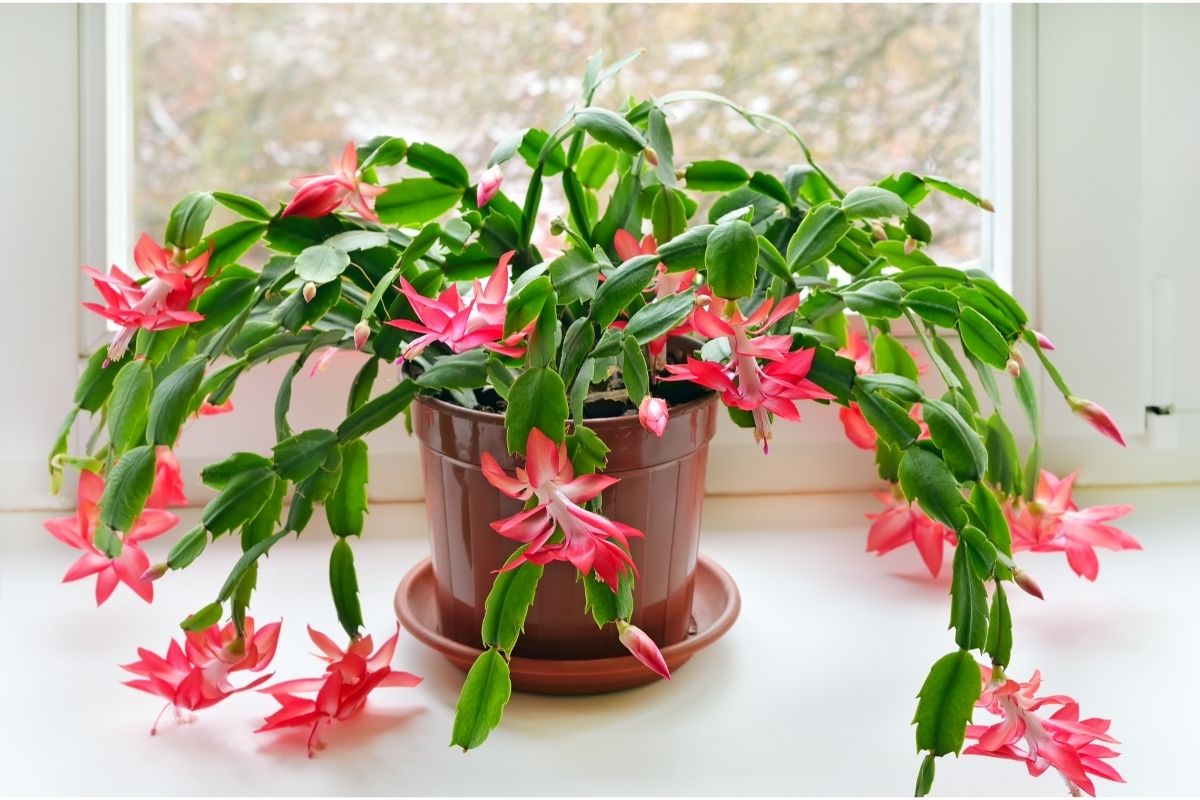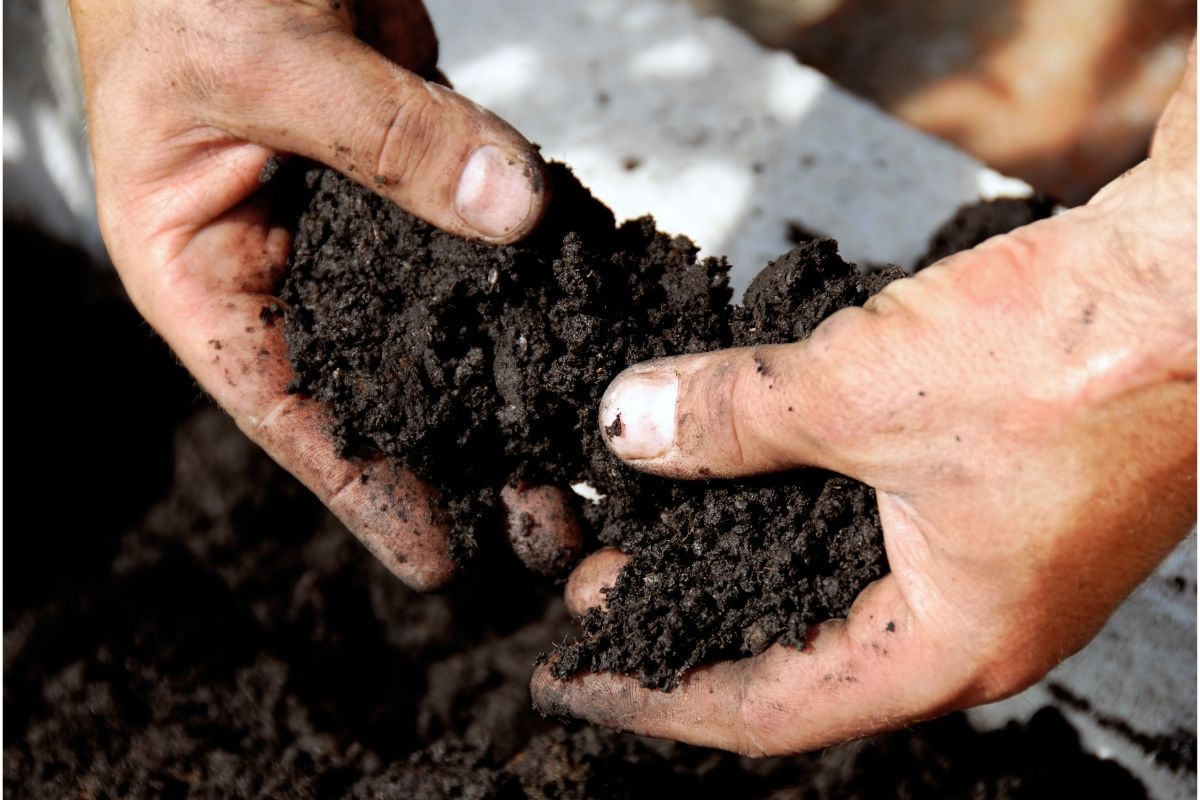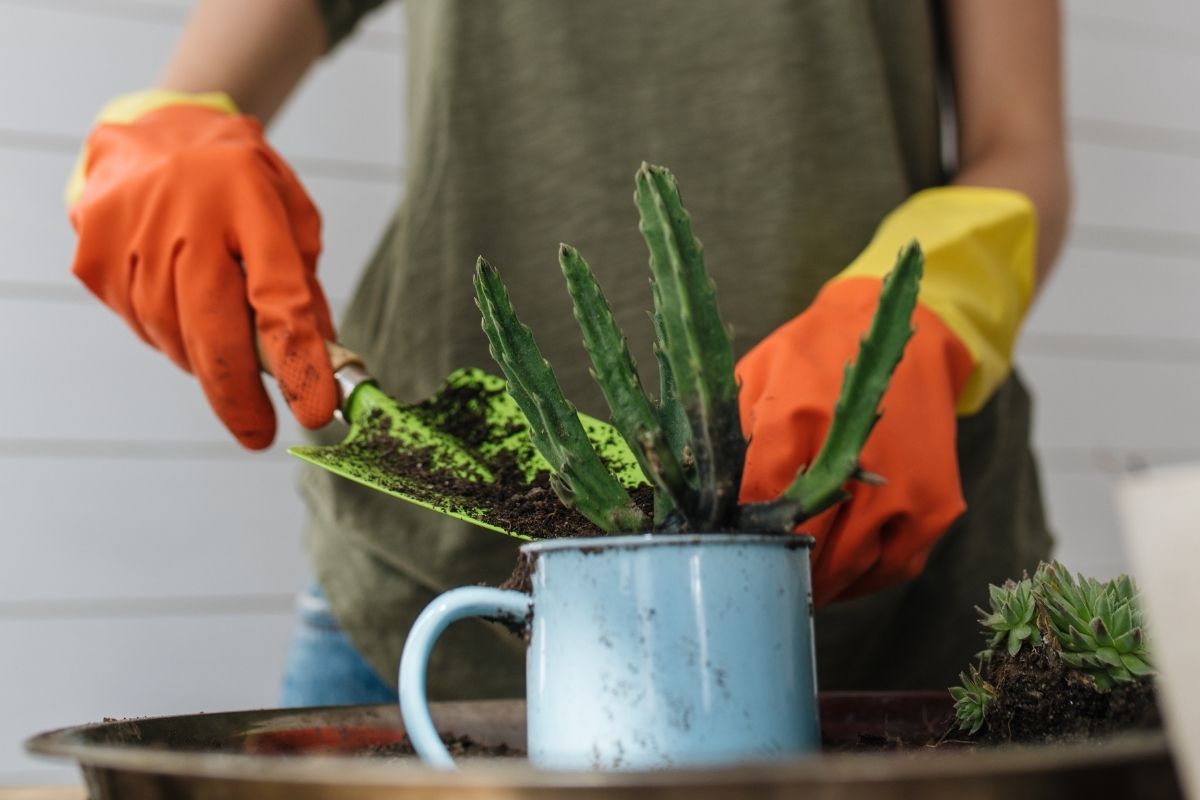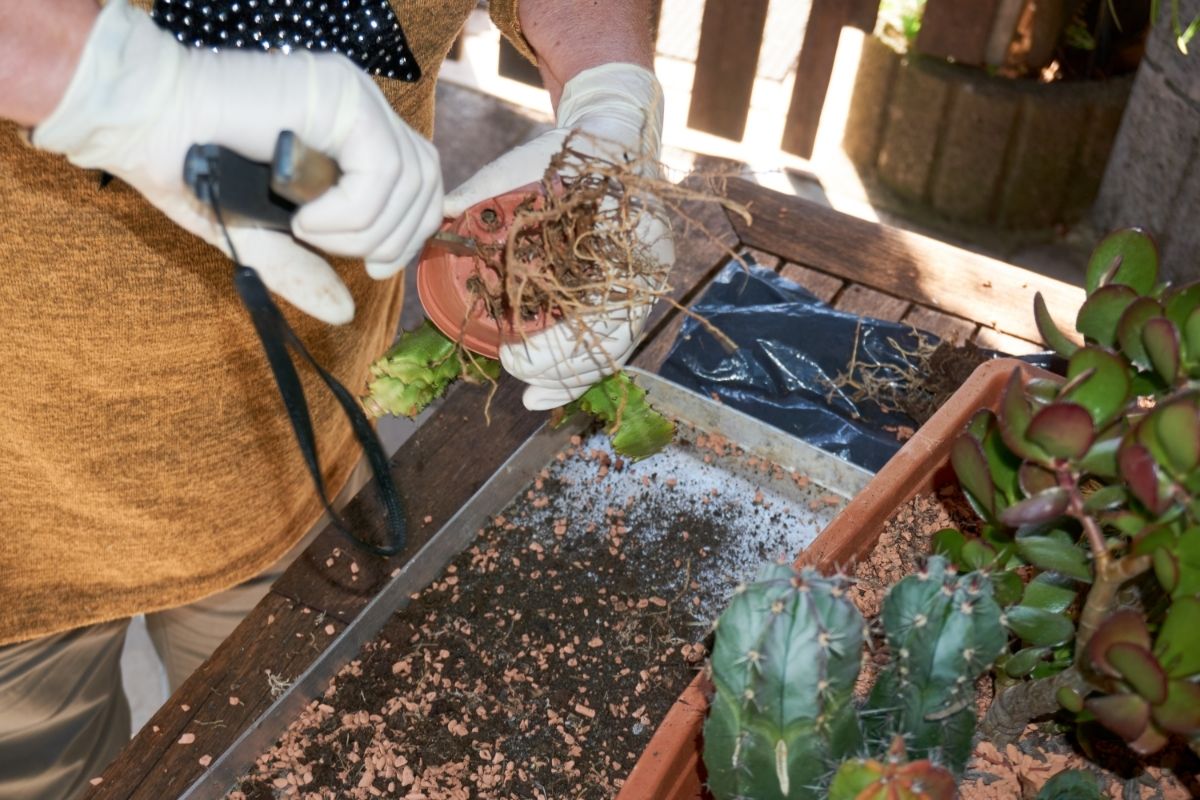Christmas cactus are popular houseplants because they thrive in average, well-lit homes where other houseplants won’t grow as easily. They are succulents and can get quite large if left alone.
For this reason, many people give them away as gifts or use them to decorate their home during the holiday season. They come in various forms such as hanging baskets, pillar pots and flat top planters.
Their leaves are long and thin. The flowers are bright reds, oranges, yellows, pink or white. There is no special care for this plant except regular watering.
Like many plants, the Christmas cactus is very easy to propagate. Because of this, you can easily make a little army of these plants if you like them enough!
If you want to propagate a Christmas cactus, keep reading to find out everything you need to know! Ready? Let’s get into it.

Propagating A Christmas Cactus
Propagating a Christmas cactus is really easy, and all you need is a cactus cutting from a mother plant, water, soil, warmth, and time.
There are two primary methods you can use to propagate Christmas cacti. The method you choose will depend on your preferences, but both work well for propagation.
There is a smaller chance of disease and infection occurring with the water method, but it does require constant attention.
The soil method, however, requires less attention in order to work, but has a higher risk of disease due to the bacteria in the soil.
Below, we will go through each of these methods and have a step-by-step guide for how to do them.
Water To Soil Method
The water to soil method starts with the cutting being placed in a glass of water, or something similar.
This water will have to be changed twice a day, and eventually the cutting from the parent plant will begin to sprout.
Once the roots reach around 2-inches long, it can then be transferred to a pot of soil to continue growing.
For a step-by-step method for propagating a Christmas cactus using the water method, see the steps below:
- Get a healthy cutting from the mother plant
- Wash off any dirt that may have fallen onto the cutting.
- Allow the cutting to sit out for 203 days, or until the cut gets calloused over. This will help reduce the chance of the cutting becoming diseased.
- Place cut side down in a glass of water until root growth begins, usually within 4 days. You will need to change the water twice a day for this duration that the cutting is in the glass.
- Remove from water after 3-8 weeks, when the root ball reaches 1-2 inches.
- At this point, plant the cutting in a plant pot with a standard cactus compost that is well-draining.
- Add small amounts of water to the newly planted cutting.
- You may need to prop the cutting up with something so that it stays planted and grows upright. Make sure that you plant the cutting deep enough, but not too deep.
- Continue to care for your cutting, and it will eventually start to grow, becoming a new and healthy plant.
Related: Ten Extraordinary Types of Tall Cactus Can Revive Your Yards and Landscapes
Straight To Soil Method
This method is exactly what it sounds like – the plant cutting is transferred straight to the potting mix without sitting in water. While this method might take a little longer than the above, it is slightly less hands-on.

For this method, all you need to do is take a healthy cutting from the mother plant, allow it to callous, then plant it in a planter. You will have to mist the soil daily to keep it moist and encourage root growth.
For a step-by-step method for propagating a Christmas cactus using the soil method, see the steps below:
- Get a healthy cutting from the mother plant.
- If there is any dirt stuck to the cutting, wash it off.
- Allow the cutting to callous over the scar. This will protect it from any bacteria in the soil.
- Moisten the soil, allowing water to penetrate for about 10 minutes.
- Plant the cutting into the potting mix. Do not overcrowd the container, as doing so could cause the roots to become tangled.
- Mist the new cutting daily until the roots begin to grow. This usually happens within 7 to 14 days. This will take some time, depending on the climate where the plants are located.
- When the plants are large enough, remove them from their containers and place them in larger pots.
Things To Consider
Before you decide to propagate your Christmas cactus, there are two important things you need to have: a healthy mother plant and patience. Why? We’ll take a look below.
Healthy Mother Plant
The Christmas cactus mother plants will need to be healthy because you are effectively cloning it through propagation.
If the mother plants are sick or weak, the baby Christmas cacti won’t grow strong and healthy roots. Also, if one part of the plant dies or becomes rotten, other parts of the plant can also die.
The best way to ensure that each mother plant is healthy, is by getting one from an established plant nursery.
Before you take a cutting from the parent plant, you need to ensure that it is free of any disease and pests. Disease and pests alike will do damage to the cutting, and likely stop it from growing.
There is no point in wasting time or money trying to propagate a cutting that has slim chances of being healthy.
Instead, wait until the mother plant is healthy and disease-free before taking a cutting to propagate. You could also go out and buy a healthy plant from a nursery
Patience
It will take between 2-3 years for the cutting to reach maturity. Before that, it can take several months before you start to see any kind of growth from the propagation.
Because of this, you need to have a lot of patience. Throughout this time, you will need to give the cutting daily attention, no matter the method you choose.
Plant Care
There are a few key things to remember with any plants. These things include the placement, watering, fertilizing, and repotting of the plants.

Below, we will go through the needs of the Christmas Cactus and find out what they need in order to thrive.
Placement
The Christmas cactus likes bright, indirect light. Direct sunlight is likely to damage the plant’s branches and leaves, causing burns.
Place the plant somewhere that is well lit in the house, but with minimal direct light.
These plants can happily live in semi-shaded areas, too, but the ideal place is a spot with enough natural light that isn’t too direct.
It should be placed at least 8 inches away from heating vents and air conditioners.
Watering
You should water your Christmas cactus every 2-3 weeks. Allow the soil to soak up the water, but not become soggy.
These plants need to have well-draining potting mix and at least one drainage hole to allow excess water to get out of the pot.
If water is left in the plant pot, the cactus could suffer from root rot, a fungal infection, and die.
Make sure you use the right material, like a cactus mix, and allow water to drain. If you are unsure of when you need to water, you can simply check to see if the top inch or two of the soil is dry.
Add some more water if it is. If not, allow the water to dissipate and wait a few more days before checking again.
Related: Solving the Dilemma Why Cacti are Not Trees and What Makes Them Plants
Fertilizing
A fertilizer formula of 20-20-20 or 20-10-20 is ideal for the Christmas cactus. Dilute the formula to 50% strength and give the plant some sometimes.
You can also give your plant a dose of magnesium sulfate solution by mixing one gallon of water with one teaspoon.
Be sure that you don’t give the plant this solution that same week that you give it any plant food, however.
Repotting
A Christmas should never be repotted when it is actively blooming. The cacti should instead be given a rest after flowering, while their roots are still active.

This allows them to heal any wounds and recover from root shock. Repot whenever you notice that the plant begins stretching out its roots and seems unhealthy.
During this time, make sure to loosen the soil around the base of the plant; there shouldn’t be much soil there.
Once the plant starts growing again, add new soil around its roots and gently pack down the old soil, so it doesn’t interfere with the new planting bed.
Pests & Diseases
These plants aren’t often bothered by pests, but do watch out for aphids on young shoots.
When these bugs appear, spray them off with a pesticide spray or use neem oil. Aphids can sometimes be found lurking beneath the leaf surfaces.
Final Thoughts
The Christmas cactus is certainly an easy houseplant to keep, and once you take care of these basic needs, they won’t disappoint you!
They are fairly forgiving with most maintenance and are happy in a variety of conditions.
With all of those benefits, you may want to consider buying a couple of extra cuttings to ensure the survival of your garden!
Frequently Asked Questions
Christmas Cactus Names
Schlumbergera truncata is the Christmas cactus’ scientific name. It is also known as the crab cactus, Thanksgiving cactus, or holiday cactus.
Does The Christmas Cactus Like Bright Light?
The Christmas cactus doesn’t mind bright light, as lost as it is not direct sunlight. Indirect sunlight is the best.
What Are Christmas Cactus’ Drainage Needs?
The Christmas cactus needs well draining soil. It should be in a pot with drainage hole.
Is Christmas Cactus Propagation Easy?
Yes, Christmas cactus propagation is easy! Any cactus propagation is easy.
Does The Christmas Cactus Like Cool Temperatures?
This plant prefers warm temperatures and likes higher daytime temperatures. Evening temperatures can drop, but not by too much.
Editor’s Recommendations
Madagascar Palm Tree: The #1 Care, Propagation, and Watering Guide
18 World Famous Yellow Cactus Varieties for Homes and Gardens
Realize Common Fungal Infections on Succulents and How to Treat Them







